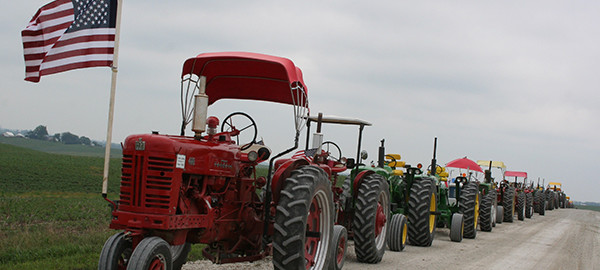The tractors will roll this weekend. It’s the Sixth Annual Adair County Historical Society Heritage Tractor Ride. In just a few short days the colors will stretch through the countryside.
Tractor rides are a farm-life phenomenon. And they’re not just for old men. Men and women of all ages join in the fun, on every kind of tractor imaginable. They gather and socialize. They enjoy the Iowa landscape at 10 mph.
They compare machines. Tractors are our classic cars. They are beautiful apparatuses. Some will come in their raw form; some painstakingly restored and decked out to the nines.
Some rides are small, simple. Some attract large crowds. When I worked at KSIB, I helped start their annual ride – that now attracts around 200 tractors the first Saturday of each June.
But for all the variants, one thing holds true – allegiance to tractor brand and color is as ingrained in a soul as religion, political persuasion, and being true to your school.
I began my involvement with tractors at an early age. My father was in the farm implement business early in his life, before the farm called him, and no color but red ever graced our farm. I still bleed red; I don’t care what those green boys try to tell me.
Nearly 20 years ago, I spent a summer working for the Historical Society and one of my projects was hosting a tractor show. For years after that one of my cohorts tried to convince me to pull together a ride. I finally acquiesced.
My first move was to put together a committee of experienced riders, and most of them are still involved today. Each year our group of five or six meets to put the details on the basic framework we’ve devised.
The ride attracts 30-40 riders each year and raises funds for the Historical Society.
Selecting a theme is part of the fun. There is always some new place or piece of history to explore. This year will focus on the Mormon Trail. The Mormons were some of the first people in the area, aside from Native Americans. They crossed southern Adair County in the horrid winter of 1846; enroute to Utah as they escaped persecution in Nauvoo, Illinois.
The trip was brutal. They fought snow, ice, mud, and a never-ending series of river crossings as they made their way across the prairie on little traveled or non-existent trails.
Along the way they planted gardens and crops and built settlements and shelters for those who came next. The Mormon Trail was used until the Transcontinental Railroad was completed two decades later.
Signs of ruts from the trail can still be seen in southwest Adair County. Their dead are buried in rustic marked graves. Existing roads follow and cross the trail. We’ll lunch at Mormon Trail Lake and enjoy a fine summer day imagining the trip via covered wagon or human-powered handcart.
There will also be memories of making hay, and plowing fresh spring earth, back when those show tractors put in a full day’s work. There will be talk of county fair tractor pulls, and maybe even a reminiscence of a team of horses or two. And a “remember when we had a four-row planter, instead of a 24-row?” Most of those memories come with a chuckle or two, and a bit of head shaking.
Farming has changed immensely in the past century. Horsepower used to be a literal term. A Farmall M was once the pride of the neighborhood. Now it travels gravel roads with Oliver 77s for recreational effect.
The world continues to demand more food. Farmers continue to rise to the occasion. They farm more and more land with bigger and bigger machines. They’ve traded gees and haws and simple carburetors for computer operated hydraulics.
But the heritage remains. History still exists in physical form. The love of the machines that turn the land is still as much a part of a farmer’s soul as the land itself.
Maybe we should all go on a tractor ride – remember where we came from, reassess where we’re going. As long as the tractor’s the right color that is. Otherwise, we could be led astray.
